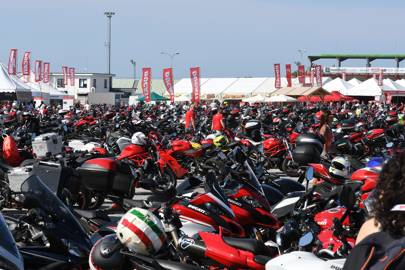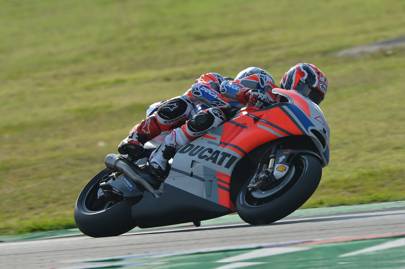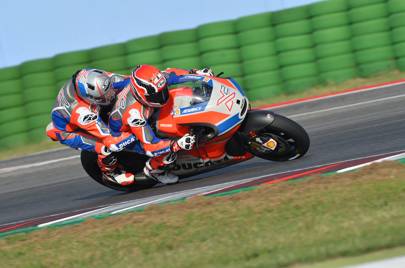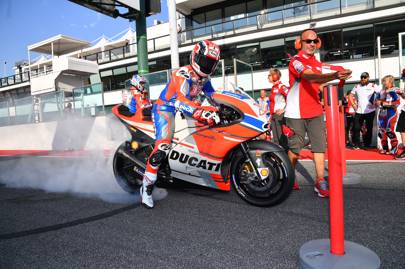As part of our summer on Ducati's 959 Panigale Corse, GQ rode a 3,000-mile round trip from Shropshire all the way down to Rimini to prove that, actually, you don't need an adventure bike to go touring, and especially not during the summer months. But the trip had a second objective – it wasn't just about crossing the alps – and that was to attend World Ducati Week.


Thousands of bikes parked up at WDW
Ducati
World Ducati Week (WDW) is a biennial celebration of all things Ducati. It takes place at Misano World Circuit Marco Simoncelli, where Ducati book the entire place out and fill the paddock and the track full of Ducati owners, fans, exhibitions and bits and pieces from Ducati's history, as well as a Race Of Champions, where all of Ducati's contracted racers battle it out on track. Some 92,000 Ducati fans attended this year's edition, turning out en masse on their prized two-wheel possessions. Ducati regularly goes on about "passion" among it customers, but in this setting it's hard to deny how much love there is out there for the brand, which is interwoven with Italy's DNA.


WDW sets out on a parade lap of Misano
Ducati
What GQ didn't know was that on the Saturday evening of WDW, Ducati would be treating us to a lap of Misano Circuit on the back of MotoGP Legend Randy Mamola's biposto (that's dual-seater) MotoGP bike. Randy needs no introduction but, just in case, he's a 13-time premier-class GP winner from California. He now devotes much of his time to philanthropy via Riders For Health, as well as sports commentary and other services to motorsport. So this was set to be a ride like no other; you can't buy it with money.
To ride pillion – let alone pilot – on a GP bike is not for the faint-hearted. Such are the physical demands of a 280bhp, 160kg machine shod with carbon brakes, slick tyres and an exhaust louder than a jet fighter that we had to pass a medical exam to even qualify for the experience. Thankfully, we passed.
There's a briefing too. You have to know how to behave on the back of such a bike: knowing how and when to lean, to look where you're going and how to hold on to the dirty great handles bolted to the tank is paramount.
Time to jump on board. Randy pulls a massive wheelie straight off the line and clicks up through three gears before the rapid right-left-right through turns one, two and three. Another quick burst of acceleration before turns four and the bike's on its ear as we negotiate turns four and five. Turn six is a similar story and the g-forces are starting to build mid-corner, showcasing the bike's incredible grip as the pace goes from red- to white-hot. Quite how Randy manages to get his knee down with a passenger onboard is unbelievable.


We're on the straight towards turn eight. The acceleration is astonishing and just relentlessly strong, to the point you can almost feel your arms stretching as the Ducati pushes on. If it had wings, it'd take off. Thank goodness there's a hump on the seat to try to take some of the strain. We've experienced crazy acceleration before but not quite on this scale.
But the overwhelming thing is the brakes. Words don't really suffice, but here's an attempt at explaining how strong the carbon brakes are on these machines. At GQ we regularly do track days on bikes. In a typical day we might get just over one-and-a-half hours on track, which might amount to, perhaps, 50 or 60 laps depending upon the length of the circuit, weather conditions and other variables. The following day we'll be a bit achey from all the acceleration and braking – quads and triceps especially – but the muscle ache will last no longer than about a day.
We did one lap with Randy around Misano and our neck ached for an entire week thanks to the braking forces. That's how night and day the brakes are when you get to this level of machinery. Forget the BMW HP4 Race's brakes – they're jawdropping, but this is a whole other level. Just imagine how fit the MotoGP riders need to be to handle the ~25 laps in a typical 40-minute race doing this corner after corner.


And it isn't just your neck that takes a battering, it's your arms too. Again, in the braking zone for turn eight, the brakes are so strong they'll transfer your entire body weight through your arms onto the handles on the tank. Your feet are off the pegs and your backside is in the air. Factor in the g-forces and you begin to realise that as much as 1.5x your body weight is currently resting on your forearms.
And yet the experience goes on. Where we'd otherwise be braking, Randy's still accelerating. And not just merely accelerating, instead actively clicking through more and more gears as the front wheel paws at the air in front of it. There's no way we're stopping for that corner that's approaching faster than fast, but, again, back to those brakes... Quite simply, a lap onboard the GP3 will completely throw out and rewrite everything you think you know about riding a bike. It's no wonder the top GP guys get called aliens.


Randy finishes off with a giant stoppie as we return to the start/finish line. "Did you enjoy that?" Yeah, Randy, we did! We enjoyed World Ducati Week too, but in a way we never imagined we might.
Like this? Now read:
How Triumph will change MotoGP
A gentleman's guide to MotoGP with Cal Crutchlow
Bagikan Berita Ini














0 Response to "Why riding Ducati's MotoGP bike with Randy Mamola should be on your bucket list"
Post a Comment